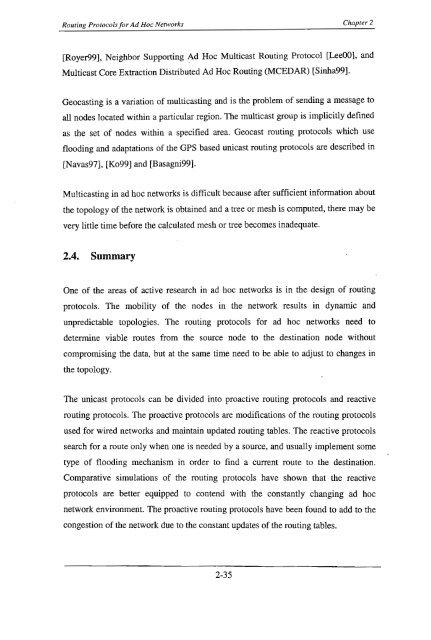Gugrajah_Yuvaan_ Ramesh_2003.pdf
Gugrajah_Yuvaan_ Ramesh_2003.pdf
Gugrajah_Yuvaan_ Ramesh_2003.pdf
You also want an ePaper? Increase the reach of your titles
YUMPU automatically turns print PDFs into web optimized ePapers that Google loves.
Routing Protocolsfor Ad Hoc Networks Chapter 2<br />
[Royer99], Neighbor Supporting Ad Hoc Multicast Routing Protocol [LeeOO], and<br />
Multicast Core Extraction Distributed Ad Hoc Routing (MCEDAR) [Sinha99].<br />
Geocasting is a variation of multicasting and is the problem of sending a message to<br />
all nodes located within a particular region. The multicast group is implicitly defined<br />
as the set of nodes within a specified area. Geocast routing protocols which use<br />
flooding and adaptations of the GPS based unicast routing protocols are described in<br />
[Navas97], [Ko99] and [Basagni99].<br />
Multicasting in ad hoc networks is difficult because after sufficient information about<br />
the topology of the network is obtained and a tree or mesh is computed, there may be<br />
very little time before the calculated mesh or tree becomes inadequate.<br />
2.4. Summary<br />
One of the areas of active research in ad hoc networks is in the design of routing<br />
protocols. The mobility of the nodes in the network results in dynamic and<br />
unpredictable topologies. The routing protocols for ad hoc networks need to<br />
determine viable routes from the source node to the destination node without<br />
compromising the data, but at the same time need to be able to adjust to changes in<br />
the topology.<br />
The unicast protocols can be divided into proactive routing protocols and reactive<br />
routing protocols. The proactive protocols are modifications of the routing protocols<br />
used for wired networks and maintain updated routing tables. The reactive protocols<br />
search for a route only when one is needed by a source, and usually implement some<br />
type of flooding mechanism in order to find a current route to the destination.<br />
Comparative simulations of the routing protocols have shown that the reactive<br />
protocols are better equipped to contend with the constantly changing ad hoc<br />
network environment. The proactive routing protocols have been found to add to the<br />
congestion of the network due to the constant updates of the routing tables.<br />
2-35
















